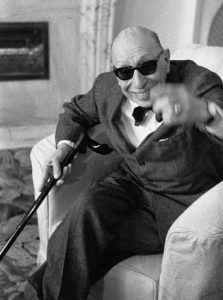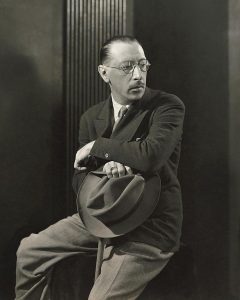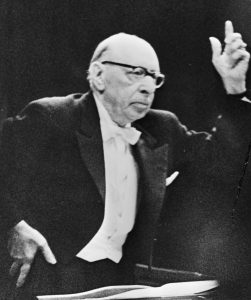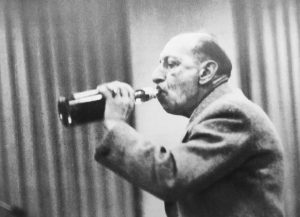
We offer up our very best birthday wishes to Igor Stravinsky, who was born 137 years ago today, on June 17, 1882.
A word of warning: saying Happy Birthday! to a Russian born before February 14, 1918 — as Stravinsky was — is an exercise in asterisks and parentheses. This is because it wasn’t until February 14, 1918 that Russia stopped using the Julian Calendar (which was named for Julius Caesar and went into effect on January 1, 45 B.C.E.) and joined pretty much the rest of world in using the Gregorian Calendar (which was introduced in October 1582 and named for Pope Gregory XIII). According to the old-style Julian Calendar, Stravinsky was born on June 5, 1882. For reasons entirely his own, Stravinsky made everything that much more complicated by celebrating his birthday on June 18. Whatever; June 17th is Stravinsky’s Gregorian Calendar birthday and a happy birthday we wish him.

Stravinsky was the defining composer of the twentieth century.
He began his compositional life as a Russian musical nationalist, writing in the style of his teacher, the great Russian nationalist composer Nicolai Rimsky-Korsakov.
But even as he studied with Rimsky-Korsakov, the young Stravinsky fell under the spell of Claude Debussy, and so inspired, he composed a number of works that reflect Debussy’s so-called Impressionist style. It was thanks to one of these works that he came to the attention of the impresario and visionary Serge Diaghilev in 1909. Diaghilev commissioned Stravinsky to compose a series of scores for the Ballet Russes, The Firebird (1910), Petrushka (1911), and The Rite of Spring (composed in 1912). The Firebird made the 28-year-old Stravinsky an international star, and the brutal (“Fauvist”) The Rite of Spring — inarguably the most important single work composed in the twentieth century — vaulted Stravinsky to the forefront of Western music, where he remained until his death (on April 6, 1971).

Like so many of his generation, Stravinsky was appalled by the catastrophic destruction and incomprehensible barbarity of World War One (1914–1918). In the years immediately following the war, he turned away from the explicit musical modernism of his pre-war music and looked for inspiration to the musical styles of the past, principally the Baroque and Classical eras, music that appeared, on its surface, to represent simpler, more “humane” times.

During the 1920s, ’30s, and ’40s, he was equally swept away by the force and energy of such “popular” musical idioms as ragtime, tango, and big-band jazz, and he composed works that evoked all of these idioms. And then in the mid 1950s and 1960s Stravinsky — now in his seventies and early eighties — underwent yet another compositional transformation and began writing ultra-modern, serial music.
(For many if not most of his friends and fans, Stravinsky’s late-in-life conversion from neo-Classicism/neo-tonalism to serialism was considered a betrayal of historic import, on the lines of those perpetrated by Judas, Brutus, Benedict Arnold and Fredo Corleone. In the 1950s, the great oppositional poles of neo-Classicism/neo-tonalism versus serialism defined the compositional politics of the day. Consequently, to see Stravinsky cross the line and not just fraternize but mate with the serialist enemy was seen by many as being as heretical as it was inexplicable!)

Stravinsky’s last major work — Requiem Canticles — was completed and premiered in 1966, 56 years after the premiere of his first major work, The Firebird.
(Requiem Canticles was premiered at the McCarter Theater in Princeton, New Jersey on October 8, 1966. Among the audience was the composer Aaron Copland and the physicist J. Robert Oppenheimer. After having heard the piece, Oppenheimer asked that it be played at his own funeral, a wish that was granted just four months later. The piece was performed as well at Stravinsky’s funeral in Venice, 4½ years later.
Musical Nationalism, Impressionism, Fauvism, Neo-Classicism, Neo-tonalism, Ultra-serialism; Stravinsky’s compositional career is a virtual catalog of styles and trends from the turn of the twentieth century to the late-1960’s. He wrote masterworks in each of these stylistic “genres”; in the case of musical Fauvism and neo-Classicism/neo-tonalism, Stravinsky composed the defining masterworks.
Variety. Variety might well be considered the catchword of not just Stravinsky’s music but his life as well. He was an international man who at one time or another made his home in St. Petersburg, Paris, London, Switzerland, Venice, Boston, Los Angeles and New York. He was a citizen of three different countries; from 1882 to 1917, Tsarist Russia; from 1917 to 1934 he was — thanks to the Russian Revolution — virtually a man without a country; from 1934 to 1945 he was a citizen of France; and finally, from 1945 to the end of his life he was a citizen of the United States. (For our information, Stravinsky’s sponsor for American citizenship was his friend, the actor Edward G. Robinson.)

Between 1905 and 1970 Stravinsky had the opportunity to meet and work with and befriend an unbelievable litany of A-listers; he was a name-dropper’s wet dream. The list of his close friends and collaborators reads like who’s who of twentieth century Western culture: Nicolai Rimsky-Korsakov, Serge Diaghilev, Vaslav Njinsky, Giacomo Puccini, Erik Satie, Claude Debussy, Maurice Ravel, Jean Cocteau, Pablo Picasso, Dylan Thomas, Nicholas Nabokov, George Balanchine, Woody Herman (!), Edward Weston, Paul Klee, Yevgeny Yevtushenko, Ingmar Bergman, John F. and Jackie Kennedy, Leonard Bernstein, Edward G. Robinson, Charlie Chaplain, Milton Babbitt, Pierre Boulez, Aldous Huxley, Serge Prokofiev, Sergei Rachmaninoff, Aaron Copland, Christopher Isherwood, T. S. Eliot, and Zsa Zsa Gabor (I kid you not); the list goes on and on and on, though mercifully I will not (though I could). The point: Stravinsky was your classic “been there, done that” sort of person. The only other twentieth century artist who could rival Stravinsky’s creative longevity, stylistic versatility, and almost universal fame was his friend and contemporary Pablo Picasso (1881–1973).

The English-American novelist Christopher Isherwood (1904–1986) was a particularly close friend later in Stravinsky’s life. Isherwood’s so-called written ‘snapshots’ of Stravinsky describe him as well (if not better!) than any photograph could:
“Stravinsky was physically adorable, so small that one wanted to protect him. The first time I saw him in his house he said, ‘Shall we listen to my Mass before we get drunk?’”
Stravinsky, in turn, recalled Isherwood:
“We have often been drunk together — as often as once a week in the early fifties, I should think — and in such different climes as Sequoia Park and the Santa Monica Beach. On Christopher’s first visit to my home [in Los Angeles] he fell asleep when someone started to play a record of my music. My affection for him began with that incident.”

(I don’t think that Stravinsky would mind me telling you — we’re all friends here, right? — that there were times when he overindulged his affection for Scotch. For example, in 1962, he was invited to dinner at the White House in celebration of his 80th birthday. In attendance were Stravinsky and his second wife Vera, President and Mrs. Kennedy, Stravinsky’s assistant Robert Craft and his old friend, the composer and writer Nicholas Nabokov, Leonard Bernstein and his wife, Goddard Lieberson (the president of CBS), Arthur Schlesinger and his wife, Pierre Salinger and his wife, and Jacqueline Kennedy’s sister Lee Radziwell. The dinner was extremely formal, as it turned out, rather too formal for Stravinsky’s taste; he got bored and drank too, too much. The evening ended poorly, as Stravinsky — the guest of honor — got so drunk that he had to leave early.)

Were you with us now, maestro, we’d open up a nice bottle of single malt, pour it neat — the way you liked it — and toast your 137th.
The happiest of birthdays to you.
For lots more on the life and music of Stravinsky, I would humbly direct your attention to my Great Courses/Great Masters survey, Stravinsky: His Life and Music.
Listen on the Music History Monday Podcast
Podcast: Play in new window
Subscribe: Apple Podcasts | Spotify | Pandora | iHeartRadio | RSS | More
